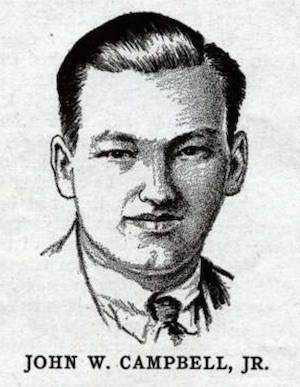| John W. Campbell: Science Fiction Technology and Ideas |
| John Wood Campbell was born in 1910; he died in 1971. He received a degree in Physics from MIT in 1923, publishing his first stories when still a student. In 1937 he became editor of Astounding Stories and discovered many great talents of sf, including Asimov, Heinlein, Sturgeon, van Vogt and others. He freely offered his ideas to his writers; Isaac Asimov has credited Campbell with the Three Laws of Robotics.
 (John W. Campbell [1931 Wonder Stories])
|
| Invention/Technology | Source Work (Publication Date) |
|
Altitude Suit |
The Black Star Passes (1930) |
|
Anti-Gravity Drive |
The Last Evolution (1932) |
|
Atomic-Powered Lifting Suits |
The Brain Pirates (1938) |
|
Automatic Cultivators |
Piracy Preferred (1930) |
|
Automatic Parking |
Twilight (1934) |
|
Building With Lunar Materials |
The Moon is Hell (1950) |
|
Chronoscope |
Elimination (1936) |
|
Credit - first use |
The Mightiest Machine (1934) |
|
Daisy Projector |
The Derelicts of Ganymede (1932) |
|
Darkness Bomb - infra-infra-infra fluorescence! |
The Mightiest Machine (1934) |
|
Electric Machine Gun (Railgun) - electromagnetic acceleration |
The Battery of Hate (1933) |
|
Electric-Space-Strain Projector - wireless power transmission |
The Mightiest Machine (1934) |
|
Energy Weapon |
The Mightiest Machine (1934) |
|
Faster-Than-Light - ftl |
Islands of Space (1931) |
|
Floater (Vehicle) |
The Machine (1935) |
|
Gyroscope Seats |
The Black Star Passes (1930) |
|
Hand Grip |
Islands of Space (1931) |
|
Helicops |
The Black Star Passes (1930) |
|
Intergalactic |
Invaders From The Infinite (1932) |
|
Jump |
Invaders From The Infinite (1932) |
| Next | Last |
(Records 1 to 20 of 51)
Technovelgy.com is devoted
to the creative inventions and technology of science fiction authors and movie makers.
Look for the Science Fiction Invention Category that
interests you, the Glossary of Science Fiction
Inventions, the Timeline of Science Fiction
Inventions, or see what's New.
Find new authors and technologies - Shop for yourself,
your library and your lab.
New on Site
Human Head Transplant
( 12/11/2025)
Robot Farm
( 12/8/2025)
Personality For Robots
( 12/5/2025)
Oblong
( 11/29/2025)
Fishcam
( 11/26/2025)
Machine Birds
( 11/18/2025)
Dingbat
( 11/14/2025)
Prowlie
( 11/11/2025)
End of Cars
( 11/11/2025)
Replacement of Brain with Computer
( 11/11/2025)
